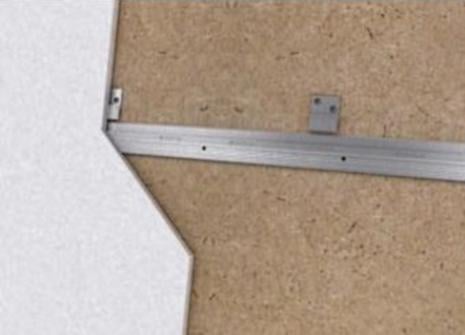Remodeling And Construction Glossary Of Terms
Interior Doors Terms and Definitions
Solid core door – This type of door has a dense interior rather than being hollow or constructed with paper fillers. They are normally very durable and usually more soundproof than hollow core doors. Solid core doors also are heavier than hollow core doors.
Hollow core door – These doors have masonite or wood veneer exteriors and the majority of the interior space is hollow or comprised of fillers. The perimeter of the interior space has a framework to provide stability. Hollow core doors are normally light.
Door slab – This is the part of the door that most people think of when they hear the term “door.” It is the part that opens and closes and is hung on the frame with hinges. Door slabs are normally hollow or solid core and they can also have glass inserts.
Pre-hung door – This is a door assembly that includes the slab, jamb, and usually the trim. The trim may be already attached if it is a split-jamb arrangement or simply included with the package so that it may be installed at the job site. Pre-hung doors are much easier to install than those requiring the jamb to be built in the field.
Door panels – Decorative recesses in a door slab are normally called panels. The most common configurations are six and four panels, but other patterns are also available. Panel doors are often found in older homes, but they can give any house a touch of elegance.
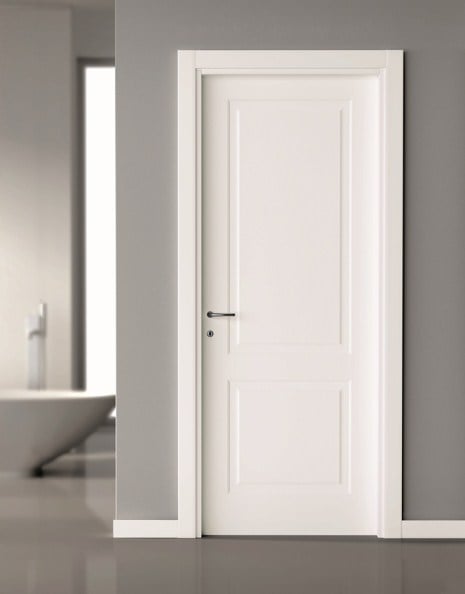
Flush door – A door slab that is smooth on both sides is called a flush door. This style is often used in contemporary homes and can also be found in many professional offices and commercial buildings. They may be referred to as Euro-style.
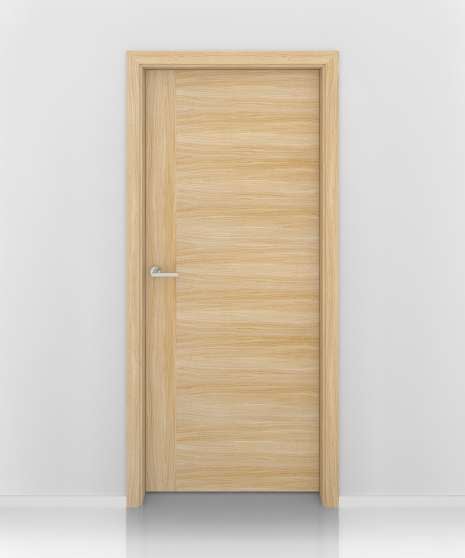
Pre-drilled door slab – A door slab that is sold with the hole already drilled for the lockset is considered to be “pre-drilled.” Most residential doors are sold this way so if you plan to use out of the ordinary locksets, make sure they are compatible with the pre-drilled slabs. Exterior doors are often pre-drilled for a lockset and a deadbolt.
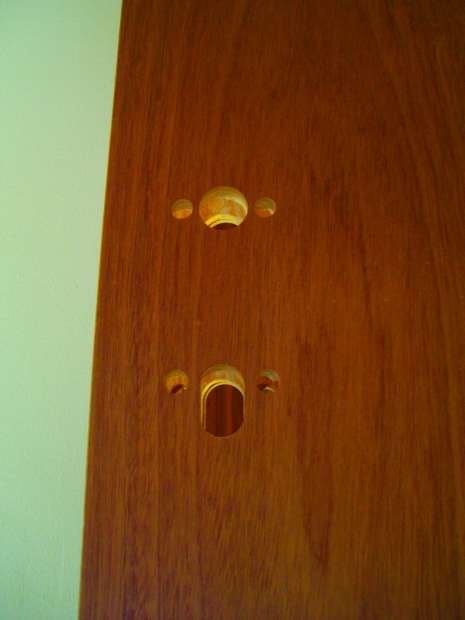
Back-set – The measurement between the edge of the door slab and the center of the lockset pre-drill is called the back-set dimension. Standard door back-sets are normally 2 3/8 or 2 ¾ inches and should match your lockset back-set dimensions. Some hardware manufacturers have adjustable locksets to fit either back-set measurement.
Door jamb – This is the trim that is installed around the inside of the framed door opening. It normally consists of one inch wood jamb material and door stop trim. A pre-hung door is sold with the jamb already constructed so it can simply be inserted into your door opening.
Door trim – The trim that picture frames your door opening is called the door trim – it normally is the same style as the window trim in the room. There are many different profiles and sizes of door trim available, but the most common styles included with pre-hung doors are colonial and contemporary in a 2 ¼ Inch width. Door trim is sometimes called casing.

Paint-grade – This term normally applies to door trim and jamb material, but it can also be used for the door slabs themselves or any other trim in the room. It means that smaller pieces of wood have been joined together to form the trim and paint rather than stain should be used for finishing. It can also be used to describe solid wood that is a lesser grade than those that are normally stained. Paint grade trim is normally more budget friendly than stain grade.
Stain grade – This is usually used to describe trim and door slabs that are constructed of solid wood that has very few defects that might detract from a stain finish. If you’re planning on staining your door slab, jamb, or trim, they should be purchased with stain grade wood.
Standard door heights – Most homes are constructed with their door openings framed to accept doors that are either 6’- 8” or 8’ tall. If you have a multi-level house, always check the door height on each floor prior to ordering new doors as some homes have 8’ doors on the main level and 6’- 8” doors everywhere else. Custom height doors are sometimes available from manufacturers.
Standard door widths – Homes are normally built with standard sized door opening widths. The most common sizes are 2’- 0”, 2’- 4”, 2’- 6”, 2’- 8”, and 3’- 0.” Always check each opening when ordering new doors as basement and utility room doors may be wider than those used for the bedroom and baths.
Rough door opening – The framed opening is normally a little larger than the door that is to be installed to allow for the use of shims when plumbing and leveling the jamb. The standard rule of thumb is that the width is 2 inches wider and the height 2 ½ inches taller, but these dimensions can vary slightly. A framed rough opening that is 32 inches wide and 82 ½ inches tall would be constructed for a 2’- 6” x 6’- 8” door.
Transom – A glass panel over an interior or exterior door is called a transom. The transom is normally the same width as the door and they are available in many different heights. If you are installing a door with a transom in a framed opening that didn’t have a transom previously, keep in mind that the framing may need to be adjusted.
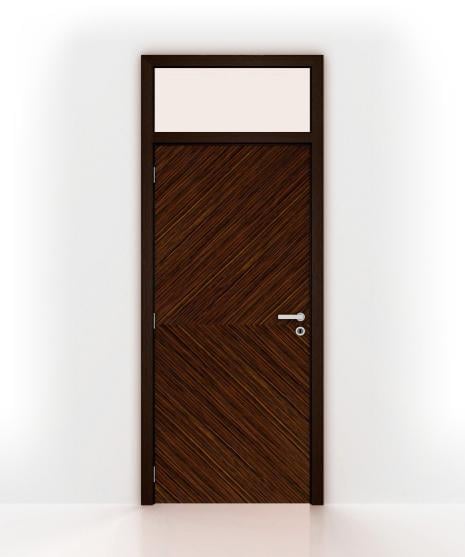
Door lites – Glass panels in doors are often called lites by industry insiders. A door with four glass panels might be referred to as a four lite door. Lites are available in many sizes and configurations.
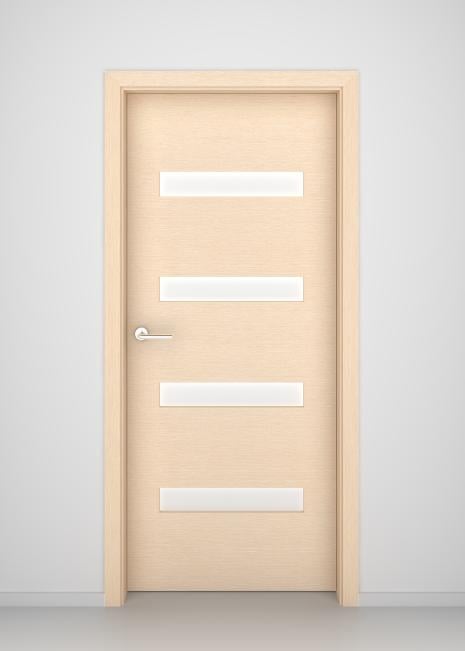
Sidelights – Glass panels on one or both sides of a door are called sidelights. Sidelights are normally the same height as the door and may be various widths. Sidelights can be almost all glass or they may have solid panels on the bottom half and glass at the top. The glass panels may be divided by trim or mullions.
French door – A double door with glass panels where both slabs are hinged is called a French door. Standard French door widths range from 4’ to 8’, but other sizes are also available. Most applications have one door that is operable and one that is stationary but can be opened when needed.

Double door – a framed opening that is large enough for two single doors may be constructed for a double door. Double doors have a single jamb for the opening, but two separate slabs that meet in the center. Double doors may be hollow core, solid core, or they can be glass. Double doors normally range from 4 to 6 feet wide, but other sizes are available.
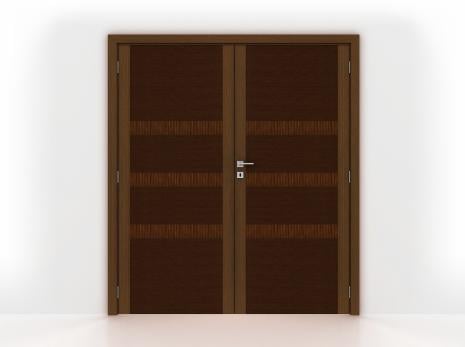
Operable door – The primary door used for ingress and egress in a double door arrangement is considered to be the operable door. It can vary based on room layout, but in many cases it is the right hand slab as you walk up to the door and it is hinged to swing away from you.
Stationary door – Double doors often have a slab that is held in place next to the operable slab or panel. A stationary door may be secured so that it never moves or it may have sliding bolts at the top and bottom that can be unlocked to allow the door to open as needed.
Louver door – A door with horizontal slats throughout the entire slab or just in one half is called a louver door. This style of door is normally used in applications where ventilation is needed such as for a utility room or at a closet. Building codes sometimes require a louvered door or ventilation grill when gas appliances are installed in enclosed spaces.
Door handing – Single swinging doors are classified as either right or left handed depending on where the hinges are located. If you stand in front of a door so that it swings away from you and the hinges are on the left, it’s a left-handed door. When the hinges are on the right, it’s a right-handed door. Door handing can be an important consideration depending on room layout and the location of light switches.

Lockset – This is the hardware that is used to open doors or hold them in place in the closed position. Residential locksets are normally “passage” that allow the door to be opened freely or “privacy” that permit the door to be locked from the inside of the room. Privacy locksets are commonly used on bedrooms and baths or any room where privacy may be desired. Passage locks are normally used on closet doors. Locksets are available in numerous styles and finishes.
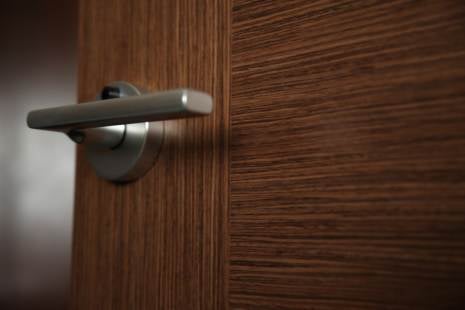
Door hinges – The hardware that connects a swinging door to its jamb is called a hinge. Most interior residential doors have two or three hinges, but heavier 8’ doors may have as many as four. Pre-hung doors have the hinges already installed, but if you’re building your own jamb, the hinges must be routed into the trim. Hinges are available in many finishes, but most pre-hung doors are sold with brass hardware.
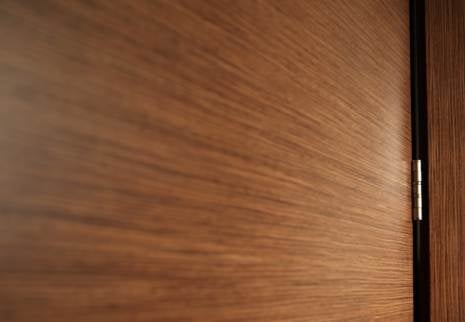
Fastener – Any piece of hardware used to secure two materials together such as a door jamb to a framed opening or a cabinet against a wall is called a fastener. Nails and screws are types of fasteners.
Wall Panels Terms and Definitions
Edging – In the world of wood wall panels, edging refers to the decorative trim that can be used between panels or to dress up an exposed end. Edging can also provide additional protection against damage to the exposed edges of your wood wall panels.
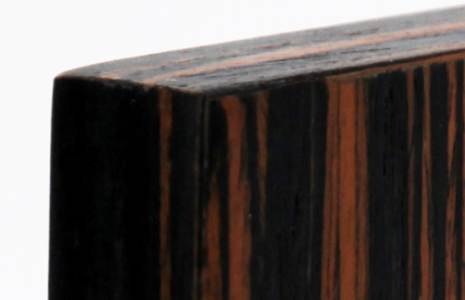
Floor molding – Also called base board, floor molding is the trim that is attached to the bottom of the walls in your home where they meet the floor. Floor molding is available in numerous sizes and is normally painted or stained.
Suspended ceiling – If there are plumbing, mechanical lines, or wiring below the ceiling framing in a room, a ceiling finish material that is attached to the framing by metal wires can be installed. This is called a suspended ceiling. Natural wood wall panels with edging can be an ideal solution where a suspended ceiling is needed.
Z – Clip – This is a piece of hardware designed specifically to hold wood wall panels securely to the wall surfaces of a room. Always check the manufacturer’s specifications to ensure you’re using the correct number of Z-clips for your application.
Existing wall finish – This is the exposed material that exists on the walls in your home’s rooms. In most cases the existing wall finish is sheetrock over wood framing, but it may also be wood, plaster, masonry, or even concrete. The existing wall finish can determine the best installation method for new wood wall panels.
Protective mask – When talking about natural wood wall panels, the protective mask is the thin membrane installed over the wood surface to provide protection during shipping. The protective mask should be left in place as long as possible during installation.
Miscellaneous Terms and Definitions
Focal point – When talking about interior décor, a focal point is an item that draws visitors’ eyes as soon as they enter a room – it may also be referred to as an accent. A focal point can be a work of art, a unique piece of furniture, or if you’re budget conscious, a beautiful section of natural wood paneling.
Room décor – The furnishings, fixtures, and finishes of a room all combine to create the room décor. There are numerous types of room decors, but a few of the most popular are contemporary, colonial, and southwestern.
Interior designer – A person who is skilled in combining furnishings, fixtures, and finishes to create a room’s décor is called an interior designer. Most interior designers have professional training and may be helpful if you’re planning a remodeling project.
Glossy finish – This is a finish that is very shiny and can add a sense of depth to wood. A glossy finish can consist of several coats of varnish or high-gloss polyurethane that also serve to protect the surface of the wood.
Clear finish – A clear finish is often referred to as a natural finish as it can be very difficult to tell that there is anything on the wood. Clear finish doesn’t alter or detract from a wood’s appearance, but still offers protection from stains and scratches.
Wood species – There are almost countless varieties of wood and each has its own unique characteristics, grain, and coloring. The wood species you choose when selecting cabinets, wall panels, or doors can have a major impact on your interior décor.
Laminate – This is a manmade material that is used as a surface on inexpensive countertops, wall panels, and cabinets. It can be manufactured with the appearance of wood, but usually lacks the warmth and value of the real thing.
Natural wood – Wood and wood veneer that comes from actual trees is considered to be natural wood. Many manufacturers now use natural wood from managed forests so the wood is considered a sustainable building material and eco-friendly.
Color variation – All natural products will display some color variation from the images shown on websites and even when seen in actuality. Granites, marbles, and all wood species display this characteristic – just like snowflakes, no two pieces of oak, maple, or any other wood are exactly the same.
DIY-friendly – A remodeling project that is simple enough that an average homeowner with a few basic tool skills should be able to accomplish it is considered to be “do-it-yourself” friendly. DIY projects are normally less expensive than those where a contractor’s expertise is required.
Kitchen Cabinets Terms and Definitions
Cabinet layout – A cabinet layout is a design or footprint of your kitchen or bath showing the proposed locations of your cabinets. Each cabinet is normally designated by its width and style such as base, wall, or vanity. Specialty cabinet locations are also shown. Cabinet layouts may be provided by a kitchen designer or cabinet supplier or you may do your own.
Kitchen designer – A person who specializes in kitchen and bath design is often called a kitchen designer. They may have a background in interior design or architecture or they may have attended classes in kitchen design. Many cabinet suppliers have a kitchen designer on staff to help customers with their selections.
Cabinet box – A cabinet box is the interior frame and outer shell of a wall or base cabinet. Cabinet boxes normally have sides, a top and bottom panel and in most cases, a rear panel. Doors and drawer faces can normally be replaced to change the style or appearance of a cabinet box.
Pre-finished cabinets – Cabinet that are shipped from the factory with a stain or paint already applied are considered pre-finished. Most manufacturers offer a multitude of finish options for their products.
Natural finish cabinets – Cabinets that are shipped without a finish are considered natural finish cabinets. Natural finish cabinets offer the flexibility of finishing the cabinets in your own unique style if you don’t mind the extra work.
Corner cabinet – A corner cabinet is designed to anchor your wall or base cabinets in a 90 degree kitchen corner. Corner cabinets normally have a 45 degree face with a hinged door or they may be set up for a blind corner configuration.
Blind corner cabinet – A blind corner cabinet is designed so that wall or base cabinets from a 90 degree intersecting wall can butt up against part of their face. Blind corner cabinets normally have a deep interior space that can only be accessed from the section that is exposed.
Lazy Susan cabinet – A cabinet that features a rotating interior tray is called a Lazy Susan cabinet. The rotating tray makes it easy to reach items that would otherwise be in the rear of the cabinet. This feature is often offered as an option in corner base cabinets and can sometimes be added into existing cabinets.
Standard base cabinet sizes – Kitchen base cabinets are normally 34 ½ inches tall which allows adding a 1 ½ inch countertop to reach a total height of 36 inches. There are many different widths of base cabinets available as standard sizes from most manufacturers.
Standard wall cabinet sizes – There are many standard heights and widths of kitchen wall cabinets available. Wall cabinets are normally installed so that their bottoms are 18 inches above the countertop, but shorter cabinets are installed over ovens, refrigerators, and sinks to clear the appliance or allow additional workspace. Most wall cabinets are 30, 36, or 42 inches tall, but other sizes are available.
Kitchen island – A kitchen island is a stand-alone arrangement of base cabinets that is separate from the room’s perimeter cabinets. They provide additional work space and can make for a more efficient cooking environment as long as the room is large enough to accommodate the island.
Kitchen prep station – A kitchen island that has a small prep sink, cutting board, or cooktop is sometimes referred to as a prep station. Prep stations can be ideal solutions for families that enjoy preparing meals together as a standard kitchen layout may sometimes feel crowded.
Backsplash – The wall space between the kitchen countertop and the bottom of your wall cabinets is called the backsplash area. There are many different materials that can be used to cover the backsplash, but ceramic tile may be the most common. Whatever you use should be easy to keep clean from cooking spatters.
Under-cabinet lights – lights that mount on the underside of wall cabinets to illuminate the countertop are referred to as under-cabinet lights. The fixtures can be hardwired to your electrical system and operated with wall mounted light switches or you can choose plug-in fixtures that are controlled by individual switches.
Breakfast bar – A breakfast bar can be created by placing a kitchen island or prep station against a framed knee wall and adding a second countertop at a higher level. The second countertop should extend out far enough to provide room for bar stools and knees.
European style – European or euro-style as it is sometimes called is a clean contemporary look without a lot of frills. Euro-style cabinets and furniture are normally much easier to keep clean than styles with many nooks and crannies.
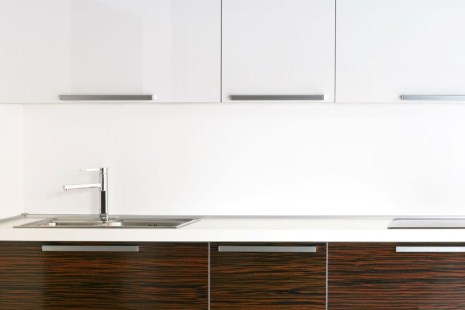
Toe kick – the recessed area at the bottom of kitchen base cabinets is called the toe kick area. Most cabinets have a black or brown toe kick, but trim to match the cabinet finish is sometimes available. Vinyl base can also be used to cover toe kick.
Cabinet valance – A cabinet valance is a decorative trim piece used to span a space between two wall cabinets. They are often used when there is a window over the kitchen sink. Valances are available in numerous styles and normally match the finish of the kitchen cabinets.
Cabinet crown molding – Cabinet crown molding is the same as crown molding often found in other rooms of the house, but it matches the kitchen cabinet finish. It is normally installed at the top of wall cabinets to add a decorative touch and is available in various widths. It may be installed even if the cabinets don’t reach the ceiling.
Specialty cabinet – A kitchen or bath cabinet designed for a specific purpose other than being a standard base, wall, or vanity cabinet is often referred to as a specialty cabinet. Microwave, oven, and trash cabinets fall into this classification.
Cabinet face – This is the front of a wall or base box. The cabinet doors are normally hinged to the face of wall and base cabinets. The face is often, but not always, in the same finish as the cabinet box and doors.
All wood cabinet construction – Higher quality cabinets are normally constructed using only wood components. Side and rear panels are plywood with wood veneers. Depending on the manufacturer and wood species, cabinets constructed using only wood can be expensive.
Composite cabinet construction – Composite cabinets usually have solid wood faces and frames, but their side and rear panels are constructed with composite or particle board. Composite board is less expensive than wood which can make these cabinets ideal for tight remodeling budgets.
RTA cabinets – RTA cabinets are “ready to assemble” units that are put together on the jobsite rather than at the factory. They are normally much more budget friendly than pre-assembled cabinets and can be easier to move around when setting up your kitchen.
Custom cabinets – Custom cabinets are units that can be built outside of the standard sizes or configurations that a manufacturer normally offers. This can be a valuable option when purchasing cabinets for an older home or a kitchen with a unique shape.
Dado joint – This is method for connecting two materials that meet at a 90 degree angle. When a dado joint is used, one of the materials is recessed into the other to create a stronger connection. Dado joints are used for higher end shelving, cabinets, and furniture.
Kitchen countertop – The food preparation and work surface that is placed on top of your kitchen base cabinets is called the countertop. There are almost countless materials that can be used as a countertop. They can range from budget friendly choices such as Formica to elegant but more expensive granite and marble.
Wood veneer – This is a thin layer of wood that is applied to plywood or composite board to create the appearance of solid wood. Veneers are available in just about any wood species and when finish is added, are almost impossible to tell from solid wood and can be a much less expensive alternative.
Sink base cabinet – A sink base cabinet appears to be a standard base cabinet, but has false drawer fronts to allow room for a kitchen sink bowl to extend down into the unit. Sink base cabinets are available in many widths and should always be situated in your kitchen design where a sink is planned. Sink base cabinets can also be used where a cooktop is to be located.
Drawer fronts – Drawer fronts are added to the front of cabinet drawer boxes to match the cabinet finish and complement the overall kitchen design. Drawer fronts are available in numerous wood species, finishes, and styles. They normally match the cabinet doors and arrive from the manufacturers already attached to the drawer boxes. It is usually possible to replace a damaged drawer front without having to replace the entire drawer.
Cabinet doors – Many wall and base cabinets have a hinged door that allows access to the interior of the cabinet. Cabinet doors normally have all-wood construction although some styles may feature wood veneer over plywood or composite board. The cabinet doors may contribute more to the overall style of your kitchen cabinets than any other component.
Double door cabinet – Wider base and wall cabinets often have double doors that meet in the middle rather than a single large door. Double door cabinets normally require less room to access the cabinet interior which can be a consideration if you have a small kitchen.
Cabinet door handing – Wall and base cabinets with a single door are either right or left hinged. Depending on your kitchen layout, this should be considered when ordering your cabinets. Some manufacturers build their cabinets so that hinging can be switched on the jobsite as needed without too much work.
Raised panel cabinet door – Raised panel cabinet doors are usually solid wood with a routed design between the door edge and center. Cathedral and arch are two of the most common styles of raised panel doors – the doors are rectangular, but the routed design has a cathedral or arched top.
Recessed panel cabinet door – A recessed panel door has a raised outer edge and the center panel sits back on a different or “recessed” plane. The recessed panel is often wood veneer that matches the solid wood outer edge. Recessed panel cabinet doors can be more budget friendly than other door styles.
Flush cabinet door – A cabinet door that has a front all on one plane is called a flush door. This door style is often used in kitchens where a contemporary or modern look is desired. It may also be referred to as Euro-style.
Cabinet panels – Many manufacturers offer decorative panels for the sides or rear of their cabinets that match the style and finish of the cabinet doors. Cabinet panels can be used to upgrade the appearance of a kitchen or to provide the finishing touch for the sides and rear of a kitchen island or breakfast bar.
Cabinet hardware – The hardware installed to facilitate the opening and closing of your cabinet doors and drawers is called the cabinet hardware. Cabinet hardware can consist of pulls, knobs, handles, or a combination of all three. Cabinet hardware can complement the look of your cabinets and can range from budget friendly to very expensive depending on the style and material.
Oven cabinet – An oven cabinet is designed to hold a built-in oven when a kitchen is designed for a separate oven and cooktop rather than a range. Oven cabinets are normally designed for a single oven, but units for double ovens are also available. Single oven cabinets may sometimes be converted on the jobsite to hold a double oven. Always check to ensure the cabinet you’re ordering will accept your oven model.
Drawer base cabinet – Standard base cabinets normally have one or two drawers at their top and doors that allow access to their lower compartments. A drawer base cabinet has a stack of drawers that make up the entire cabinet – the drawers often vary in height with larger units being at the bottom.
Pantry cabinet – A pantry cabinet is a specialty cabinet designed with numerous shelves and sometimes drawers to hold kitchen supplies and tools. Pantry cabinets normally sit on the floor like a base cabinet, but may extend up so that they’re even with the height of your wall cabinets. Pantry cabinets are available in several widths and configurations.
Adjustable shelves – Most wall cabinets over 12 or 15 inches in height have shelves that can be adjusted to various heights depending on what you plan to place in the cabinets. The shelves in base cabinets are usually fixed in place.
Drawer slides – This is the hardware that allows the drawer boxes to open and close. There are various types of drawer slides and they can normally be replaced without having to purchase a new drawer or cabinet.
Refrigerator panel – Trim panels that match your cabinet finish are sometimes available to cover the front panel of your refrigerator. Only certain models of refrigerators are set up to receive cabinet trim panels so verify that you have one of those types of appliances prior to ordering a panel.
Cabinet refacing – This is a very budget friendly method of giving your existing kitchen cabinets a whole new look. It involves replacing the cabinet doors and drawer fronts with new pieces and installing a new veneer on the face of the cabinets.
Vanity cabinet – A sink base cabinet located in the bathroom is normally referred to as a vanity cabinet. Most vanity cabinets have single or double doors, but wider models may also have a stack of drawers. Vanity cabinets are available in numerous sizes and finishes.
Double bowl vanity cabinet – A vanity cabinet wide enough to accommodate two sink bowls is called a double bowl vanity. Most double bowl vanities are at least 60 inches wide. It is possible to create a double bowl vanity cabinet configuration by installing two single vanity cabinets rather than a single wide cabinet.
Standard vanity sizes – Vanity cabinets are available in many standard widths that can start at about 18 inches and range up to 72 inches or larger. Most vanity cabinets are 30.5 inches tall, but other heights are sometimes available.
Linen cabinet – Linen cabinets are similar to kitchen pantry cabinets in that they are tall and set up for storage. If you don’t have a built-in linen closet in your bathroom, a linen cabinet can be the ideal solution for storing clean towels and cleaning supplies.
Above the toilet cabinet – This is an accessory storage cabinet designed to be installed on the wall above your toilet. They are normally available in standard cabinet finishes and consist of several shelves and a hidden storage area accessible through hinged doors.
Vanity cabinet hardware – The pulls, knobs, or handles used to open your vanity cabinet doors and drawers are called the vanity cabinet hardware. They can often be matched to the finish of your plumbing fixture hardware.
Vanity top – The surface installed on top of your vanity cabinets is referred to as the vanity top. The vanity top may have one or more pre-formed sink bowls already installed or it may have cutouts for under-mount or drop-in sink bowls. There are numerous vanity top materials available, but cultured marble may be the most popular due to its affordability and attractive appearance.
Vanity cabinet configurations – There are many different cabinet arrangements possible when planning for your bathroom vanity cabinets. Configurations can range from a single cabinet to a row of cabinets that may consist of sink and drawer bases alternated for multiple bathroom users. Sitting areas can also be created by leaving an open spot between cabinets that is spanned by the vanity top.
Pencil drawer – A pencil drawer is a shallow height drawer that is suitable for smaller personal hygiene accessories. The top drawer in a vanity drawer cabinet is often a pencil drawer.
Cabinet depth – Almost all kitchen and bathroom cabinets are 23 ½ inches deep, but when placing two cabinets together such as a linen cabinet and vanity, it can be a good idea to verify that they are the same depth prior to placing your order.
Samples – Many building supply vendors offer the opportunity to order samples of their products. Samples can help you get a better idea of color and style and can be of great assistance when coordinating paint and flooring selections.
Plumbing rough-ins – Plumbing supply and drain lines that extend out of the wall or floor so fixtures can be attached are referred to as rough-ins. Your vanity cabinet that will contain your sink bowl should always be situated where the sink plumbing rough-ins are located.



